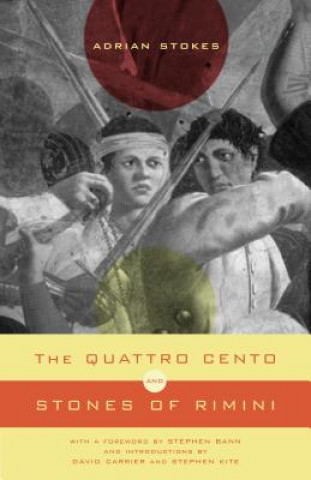
Kód: 11362234
The Quattro Cento and Stones of Rimini
Autor Adrian Stokes, Stephen Bann, David Carrier
Adrian Stokes (1902-1972) was a British painter and author whose writings on art have been allowed to go out of print despite their impact on Modernism and ongoing acclaim for their beauty and intellectual acuity. Two of his most ... celý popis
- Jazyk:
 Angličtina
Angličtina - Vazba: Brožovaná
- Počet stran: 266
Nakladatelství: PENNSYLVANIA ST UNIV PR, 2002
- Více informací o knize

1874 Kč
Dostupnost:
50 % šance Máme informaci, že by titul mohl být dostupný. Na základě vaší objednávky se ho pokusíme do 6 týdnů zajistit.
Máme informaci, že by titul mohl být dostupný. Na základě vaší objednávky se ho pokusíme do 6 týdnů zajistit.Prohledáme celý svět
Mohlo by se vám také líbit
-

Dune
216 Kč -

Haunting Adeline
621 Kč -

Berserk Deluxe Volume 2
1092 Kč -

White Nights
89 Kč -

Powerless
268 Kč -

Atomic Habits
330 Kč -

Dune Messiah
228 Kč -

Berserk Deluxe Volume 3
1142 Kč -

One Day
221 Kč -

Berserk Deluxe Volume 1
1115 Kč -

Iron Flame
368 Kč -

Surrounded by Idiots
213 Kč -

Harry Potter and the Prisoner of Azkaban (Minalima Edition)
993 Kč -

Gravity Falls Journal 3
443 Kč -

Heaven Official's Blessing: Tian Guan Ci Fu (Novel) Vol. 1
420 Kč -

The Creative Act
568 Kč -

Dune
276 Kč -

Hunting Adeline
624 Kč -

A Little Life
290 Kč -

Children of Dune
230 Kč -

Heaven Official's Blessing: Tian Guan Ci Fu (Novel) Vol. 2
427 Kč
Dárkový poukaz: Radost zaručena
- Darujte poukaz v libovolné hodnotě a my se postaráme o zbytek.
- Poukaz se vztahuje na celou naši nabídku.
- Elektronický poukaz vytisknete z e-mailu a můžete ihned darovat.
- Platnost poukazu je 12 měsíců od data vystavení.
Informovat o naskladnění knihy
Zadejte do formuláře e-mailovou adresu a jakmile knihu naskladníme, zašleme vám o tom zprávu. Pohlídáme vše za vás.
Více informací o knize The Quattro Cento and Stones of Rimini
Nákupem získáte 187 bodů
 Anotace knihy
Anotace knihy
Adrian Stokes (1902-1972) was a British painter and author whose writings on art have been allowed to go out of print despite their impact on Modernism and ongoing acclaim for their beauty and intellectual acuity. Two of his most influential books, The Quattro Cento of 1932 and Stones of Rimini of 1934, are brought together for the first time in this new volume, which includes all their original illustrations. This new edition also provides a foreword by Stephen Bann and introductions by David Carrier and Stephen Kite that place Stokes's masterworks in the context of early twentieth-century culture and discuss their structure and relevance to today's experience of art and architecture.Written as parts of an incomplete trilogy, The Quattro Cento and Stones of Rimini mark a crossroads in the transition from late Victorian to Modernist conceptions of art, especially sculpture and architecture. Stokes continued, even extended, John Ruskin's and Walter Pater's belief that art is essential to the individual's proper psychological development but wove their teaching into a new aesthetic shaped by his analysis with Melanie Klein and recent innovations in literature, dance, and the visual arts.Few writers have been able to invoke the material presence of works of art in the way Stokes does in The Quattro Cento and Stones of Rimini. They combine travel writing with acts of looking spun out so as to reinterpret the imposing legacy of the Italian Renaissance through an aesthetic of the direct carving of stone, which has parallels in the sculpture of Henry Moore and Barbara Hepworth but was for Stokes the discovery of artists in fifteenth-century Italy. To his way of thinking, there then arosea realization that the materials of art "were the actual objects of inspiration, the stocks for the deepest fantasies." During the Renaissance, Stokes maintained, stone accordingly "blossomed" into sculpture and buildings, such as the Tempio Malatestiano, that throw "inner
 Parametry knihy
Parametry knihy
Zařazení knihy Knihy v angličtině The arts History of art / art & design styles History of art & design styles: c 1400 to c 1600
1874 Kč
- Plný název: The Quattro Cento and Stones of Rimini
- Autor: Adrian Stokes, Stephen Bann, David Carrier
- Jazyk:
 Angličtina
Angličtina - Vazba: Brožovaná
- Počet stran: 266
- EAN: 9780271022178
- ISBN: 0271022175
- ID: 11362234
- Nakladatelství: PENNSYLVANIA ST UNIV PR
- Hmotnost: 1061 g
- Rozměry: 227 × 152 × 45 mm
- Datum vydání: July 2002
Osobní odběr Praha, Brno a 12903 dalších
Copyright ©2008-24 nejlevnejsi-knihy.cz Všechna práva vyhrazenaSoukromíCookies


 Vrácení do měsíce
Vrácení do měsíce 571 999 099 (8-15.30h)
571 999 099 (8-15.30h)